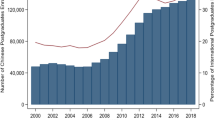Abstract
The past decades have witnessed an impressive growth of international student mobility. This article presents first empirical evidence on international student migration to Germany, one of the most important destination countries for international students worldwide. While previous research in the field has mainly used data on international trade in educational services, I use a novel approach that analyzes student mobility as a form of migration, using data on international student migrants. An augmented gravity equation is the basis for the theoretical and empirical framework. I also provide extensive sensitivity checks of the empirical results and estimates using both the usual log-linearized and a multiplicative specification of the gravity equation, following recent work by Santos Silva and Tenreyro (Rev Econ Stat 88(4): 641–658, 2006). The results provide evidence for the importance of distance—a familiar result from the empirical migration literature. Unlike for international migration on the whole, the importance of disposable income in the home country does not seem to be too big for students, and student migrant flows from politically unfree countries are significantly lower.
Similar content being viewed by others
References
Buch CM, Kleinert J, Toubal F (2004) The distance puzzle: on the interpretation of the distance coefficient in gravity equations. Econ Lett 83: 293–298
Clair G, Daulier G, Mayer T, Zignago S (2004) Notes on CEPII’s distances measures. Downloaded from the CEPII’s web page: http://www.cepii.fr/distance/noticedist_en.pdf
Dia IA (2005) Migrations internationales estudiantines, internationalisation de l’enseignement superieur et fuite des cerveaux. Global migration perspectives no. 54
Dreher A, Poutvaara P (2006) Student flows and migration: an empirical analysis. KOF working papers no. 142
Ghatak S, Levine P, Price SW (1996) Migration theories and evidence: an assessment. J Econ Surv 10(2): 159–198
Gourieroux C, Monfort A, Trognon A (1984) Pseudo maximum likelihood methods: applications to Poisson models. Econometrica 52: 701–720
Hatton TJ, Williamson JG (2002) What fundamentals drive world migration? NBER working paper no. 9159
Hausman JA (1978) Specification tests in econometrics. Econometrica 43: 1251–1271
Karemera D, Iwuagwu Oguledo V, Davis B (2000) A gravity model analysis of international migration to North America. Appl Econ 32: 1745–1755
Kim J (1998) Economic analysis of foreign education and students abroad. J Dev Econ 56: 337–365
Larsen K, Martin JP, Morris R (2002) Trade in educational services: trends and emerging issues. World Econ 25(6): 849–868
Massey DS, Arango J, Hugo G, Kouaouci A, Pellegrino A, Taylor JE (1993) Theories of international migration: a review and appraisal. Popul Dev Rev 19(3): 431–466
Overman HG, Redding S, Venables AJ (2003) The economic geography of trade, production and income: a survey of empirics. In: Harrigan J, Kwan Choi E (eds) Handbook of international trade, 1st edn. Blackwell Publishers, Oxford
Pedersen PJ, Pytlikova M, Smith N (2008) Selection and network effects—migration flows into OECD countries 1990–2000. Eur Econ Rev 52(7): 1160–1186
Santos Silva JMC, Tenreyro S (2006) The log of gravity. Rev Econ Stat 88(4): 641–658
The Economist (2005) Free degrees to fly, The Economist, February 26, 2005:63–65
Tinbergen J (1962) Shaping the world economy—suggestions for an international economic policy, 1st edn. The Twentieth Century Fund, New York
Tremblay K (2002) Student mobility between and towards OECD countries in 2001: a comparative analysis. In: OECD (ed) International mobility of the highly skilled, 1st edn. OECD Publications, Paris
Tremblay K (2004) Links between academic mobility and immigration. Paper presented at the world education services’ symposium on international labour and academic mobility: emerging trends and implications for public policy, 21–22 October 2004, Toronto
Wooldridge JM (1999) Distribution-free estimation of some nonlinear panel data models. J Econ 90: 77–97
Author information
Authors and Affiliations
Corresponding author
Rights and permissions
About this article
Cite this article
Bessey, D. International student migration to Germany. Empir Econ 42, 345–361 (2012). https://doi.org/10.1007/s00181-010-0417-0
Received:
Accepted:
Published:
Issue Date:
DOI: https://doi.org/10.1007/s00181-010-0417-0




